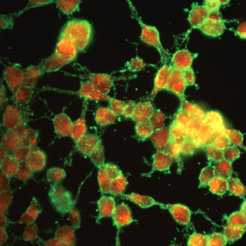„Superweapon“ Oct4 creates stem cells for therapy of spinal cord injuries
First publication with Max Planck partner group in „Hans Schöler Stem Cell Research Center“ in South Korea
Owing to a myelin sheath that is spirally wrapped around nerve fibers, neurons can adequately conduct their signals. In the brain, this lipid layer is made by so called oligodendrocytes. The importance of this myelin sheath is becoming apparent in demyelinisating dirsorders such as Multiple Sclerosis. Also in therapy concepts for spinal cord injuries, remyelinisation is central. Professor Dr. Jeong Beom Kim, leader of the Max Planck partner group at the 'Hans Schöler Stem Cell Research Center' in Ulsan, South Korea, has shown in collaboration with PD Dr. Holm Zaehres from the department of Professor Dr. Hans Schöler that the protein Oct4 - with a certain combination of culture media - can very efficiently reprogram skin cells into oligodendrocyte precursor cells (iOPCs). The scientists have tested those cells for the first time in a rodent model for spinal cord injuries - with success: the mobility improved after transplantation (EMBO Journal Issue 23, Dezember 2, 2015). This study shows that iOPCs help to understand demyelinisating disorders. Moreover, this approach could be important for future therapies of spinal cord injuries and demyelinisating disorders.


The ‚Hans Schöler Stem Cell Research Center’ in Ulsan, South Korea, was inaugurated on August 13, 2010 and is dedicated to exploring the possibilities of the iPS technologie in regard to cell replacement therapies.
The Max Planck partner group at the ‚Hans Schöler Stem Cell Research Center’ was initiated in 2012 by the Max Planck Institute for Molecular Biomedicine and is headed by Professor Dr. Jeong Beom Kim, who did research on his doctoral thesis from 2005 until 2009 with Hans Schöler. The Max Planck partner group was positively evaluated after three years and will be up and running until the end of 2016. The partner group intensifies the existing cooperation between the two institutions.

